New natural gas pipeline requires advanced multi-process welding technology from Miller Electric Mfg. Co. to perform critical welds on high-yield strength X80 pipe. The Cheyenne Plains Gas Pipeline Co. reports the following benefits:
- PRO 300’s downhill welding performance with a cellulosic Stick electrode meets or exceeds that of a DC generator.
- Its CV output provides outstanding control for flux-cored applications.
- It provides stronger welding generator output in a machine that is 35-percent more compact than a DC generator.
- Reduced fuel use on the project by 40 percent.
- Helped reduce and eliminate concerns related to hydrogen cracking.
- SuitCase® 8VS fed and protected flux cored wire well under harsh conditions.
- Invision™ 456MP inverter made almost all of the mechanized mainline welds and due to reliability in harsh conditions.
Cheyenne Plains Pipeline Project Requires Modern Welding Technology
Cheyenne Plains Gas Pipeline Co. recently constructed a new $425 million natural gas pipeline from just south of Cheyenne, Wyoming to Greensburg, Kansas. Providing an outlet for the growing supply of Rocky Mountain natural gas to markets in the Midwest region of the United States, Cheyenne Plains will be able to transport up to 730,000 dekatherms (1.7 billion cubic feet) of natural gas per day. This is enough energy to power about 10 million homes.
The 380 miles of 36-inch pipe and 5 miles of 30-inch lateral pipe was constructed of X80 steel, a material never before used for pipelines in the United States. Worldwide, the project nearly doubled the amount of X80 in use. This story discusses the new semi-automatic and manual welding techniques and equipment used to ensure quality on the approximately 400 tie-in welds made at river and road crossings on Spread 1.
Tougher Steel Increases Welding Challenges
To reduce natural gas pipeline costs, companies generally want to reduce the tonnage of steel used (steel is sold by weight) and/or increase line pressure to transport more cubic feet per hour of gas. Of course, pipeline companies must perform a balancing act when selecting a grade of steel to use, weighing pipe wall thickness vs. pressure capabilities, D/T (diameter to thickness) ratios and weldability issues. X80 provides a good opportunity to reduce steel tonnage(especially beneficial during the current steel shortage(while maintaining or increasing compression. The new pipeline has approximately 32,675 nameplate HP compression and associated treating facilities at Cheyenne Station, Weld County, Colorado.
X80 is a microalloyed steel pipe with a minimum yield strength of 80,000 lbs. (yield strength is the amount of applied stress under which an object will stretch and return to its original shape without taking a permanent set). With its higher yield strength, X80 pipe reduces pipe wall thickness without sacrificing integrity. The 36-in. diameter pipe on the Cheyenne plains project is 0.469 in. on the mainline and increases to 0.678 in. on the road and river crossings. Compare these measurements to the X70 used on recent projects, where the 36-in. diameter mainline pipe had a wall thickness of 0.622 in. to operate at similar design pressures.
Thinner-walled X80 pipe saves money two ways. First, it lowers the cost per foot by reducing the total steel tonnage purchase (Cheyenne Plains used 181,000 tons of 36-in. X80). Additionally, thinner-walled pipe requires less filler metal to complete the joint, thereby reducing the cost of welding consumables and time.
However, welding X80 is more difficult than welding X70 steel because it is prone to hydrogen cracking. Searching for ways to avoid this problem significantly influenced the tie-in welding procedures developed for the project, as well as the selection of welding power sources and wire feeders from Miller Electric Mfg. Co., filler metals from Hobart Brothers, and guns and consumables from Bernard.
The Plan
Cheyenne Plains worked with EWI Microalloying International of Houston (a partnership between the Edison Welding Institute and Microalloying International) to evaluate and test tie-in welding procedures that would join the pipe. The contractors selected for the project also participated, including Associated Pipe Line Contractors, Inc., the Houston-based company responsible for the 124.8 miles of Spread 1, the northernmost Spread. Local 798 welders and helpers provided the hands-on welding to ensure that the welding process(es) and equipment would meet the welding procedure requirements.
The procedures for mainline welding, done with a mechanized process to improve productivity to an average of 130 joints per day, were relatively similar to those used on the Kern River, Vector and Alliance Pipelines. On the Cheyenne Plains project, the root pass (an internal bead pass) and the hot pass (an external pass) were done with short circuit MIG (GMAW) welding using a 0.035-in. ER70S-G solid wire and 75/25 argon/CO2 shield gas mixture. The fill and cap passes (one each) were both done using pulsed MIG, 0.040-in. ER70S-6 solid wire and 85/15 argon/CO2 shield gas mixture. Miller inverters, including the Invision™ 456MP with built-in pulsing controls, made nearly all the mechanized welds because of their proven ability to withstand dusty and hot conditions (see Fig. 1) on previous pipeline projects. An automatic 8-headed internal welding system for root bead welding and dual torch welding systems for fill and cap passes. The external hot pass was completed by conventional short-arc GMAW.
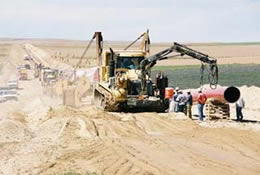 |
Fig. 1 Despite the dusty environment, welders from Local 798 and Associated Pipe Line Contractors Inc. were able to lay 124.8 miles of pipe without having a problem with a single Miller Electric Invision 456MP power source.
|
Specifying the manual (Stick) and semi-automatic (flux-cored) welding procedures for the tie-in welds was more challenging. As noted, X80 pipe is more susceptible to hydrogen cracking, which means that procedures commonly used for welding pipe with lower yield strength properties-such as downhill welding all passes with a celluosic (e.g., E6010, E9010) electrode(needed to be evaluated and adjusted according to the client and metallurgists' requirements for this project. However, the pipeline welders of Local 798 are most familiar with Stick welding (SMAW) and as a result, the contractors and welders involved with developing the weld procedures would have preferred to use the cellulosic welding consumables and techniques. To assist in mitigating the risk of hydrogen induced cold cracking, low hydrogen welding considerations needed to be evaluated and qualified.
"We either had to incorporate low-hydrogen Stick electrode (e.g. E9018) electrodes or qualified flux-cored welding procedures to address the metallurgists' hydrogen concerns," said Sonny Weems, assistant superintendent with Associated Pipe Line. "We went to Houston and spent five days evaluating, testing and verifying procedures using both celluosic and hydrogen electrodes. Welding uphill with a flux-cored wire was a lot quicker than welding uphill with a low-hydrogen Stick electrode, so that's what we selected."
The procedure qualification worksheet for the project notes that travel speeds with a 1/8-in. E9010M Stick electrode for the fill and cap passes average 2 to 4 inches per minute, while the fill and cap passes welded with a .045-in. E101K2 flux cored wire average 4 to 6 inches per minute.
Paul Manuel, a subcontractor to EWI Microalloying, provided welding and QA expertise on the project and notes that a tent to shield the weld from the wind was necessary for flux-cored processes in order to prevent porosity.
"From an operational standpoint, it quickly became obvious that uphill flux-cored welding outperformed uphill welding with a low-hydrogen Stick electrode," said Manuel, "especially in terms of welding speed, operator training, preference and qualification. The welders needed to pay additional attention to details to meet the weld inspection requirements."
The final tie-in weld procedure Associated Pipe Line selected involved making a downhill root, or bead, pass with a 5/32-in. E6010 electrode running at 135 to 155 amps and 22 to 25 volts. The ductility of this filler metal lends flexibility to the pipe, which helps prevent the joint from cracking. The downhill hot pass, which consumes most of the bead pass, was made with a 3/16-in. E9010 electrode running at 150 to 185 amps and 25 to 34 volts in order to increase the strength and toughness of the weld and to eliminate root bead slag inclusions.
The fill and cap passes were made with .045-in. E101K2 flux-cored wire, 75/25 argon/CO2 shield gas mixture, running at 165 to 175 amps (a wire feed speed of 275 to 290 inches per minute) and 23 to 24 volts. The properties of this electrode are compatible with the properties of the base metal, helping to address concerns about hydrogen cracking, yield strength and toughness.
Consumables and Equipment
As the first X80 project in the United States and one of the earliest worldwide, all components of the manual and semi-automatic welding process had to be evaluated. At the same time the welding procedures were being developed, Associated Pipe Line also evaluated different brands of welding equipment and consumables.
For Stick welding, Associated Pipe Line selected Pipemaster® E6010 and E9010 electrodes from Hobart Brothers (Fig. 2). Pipemaster® 9010 electrodes are specifically designed for welding high-yield strength pipe and meet the requirements of AWS 5.5 low alloy specifications and pipeline API Code 1104. The electrode has a smooth, yet forceful arc that provides good penetration and fusion with excellent control. Its superior wetting characteristics offer freedom from internal undercutting with practically no slag, which minimizes slag entrapment. Weems said the Hobart Brothers electrodes were found to run smoothly and with low spatter. Denton Thompson, an account manager at Airgas' Fort Collins, Colo., location adds, "Other companies have comparable electrodes, but in the end Associated chose Hobart Brothers to do the job and was pleased with the results." Airgas is the welding supply distributor that supported Associated Pipe Line on this project, including supplying approximately 10,000 lbs. of filler metals.
| Fig. 2 About 5,000 lbs. of Pipemaster 9010 stick electrodes from Hobart Brothers were used on the first 125-mile section of the pipeline tie-ins. The Pipemaster 9010 electrodes were specifically designed for welding high-yield strength pipe. |
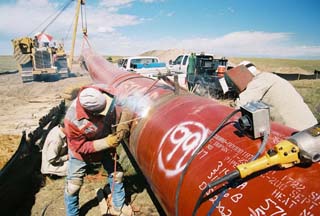 |
For the flux-cored welding, Associated Pipe Line chose Hobart Brothers' Pipemaster® 101K2 flux-cored wires. This all-position flux-cored wire is suitable for vertical up-pipe welding, providing excellent toughness combined with yield strengths above 80,000 psi, and low diffusible hydrogen levels. It combines a smooth, stable arc, low smoke and low spatter levels. The quick-freezing slag is ideal for high-deposition welding and also maintains a flat bead profile (Fig 3).
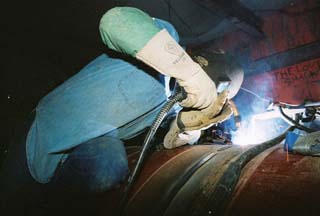 |
Fig. 3 Note the flat bead profile provided by the Pipemaster 101K2 flux cored wire.
|
"The welders practiced with the Pipemaster flux-cored wire in order to become more comfortable with the process," says Thompson. "As a result, they developed the skills needed to pass qualification and start the job." It is important to note that some of the operators had little to no experience with flux-cored welding prior to this project, which attests to their skill and adaptability considering they mastered the techniques."
Once Associated Pipe Line had chosen the electrodes, they needed to select a diesel engine-driven welding generator that provided outstanding performance for both Stick and flux-cored welding. In addition, the engine drive would need to withstand the hot, dusty Colorado summer; breakdowns in remote locations(40 or more miles from the construction yard( could result in hours of lost productivity. For this reason, Associated Pipe Line wanted to use engine drives based on traditional technology (e.g., no inverters or choppers).
"While in Houston, we made practice welds and tried out some wire feeders," says Weems. "The PRO 300 CC/CV from Miller met our needs for using both Stick and flux-cored electrodes. We had welders put CV boxes (constant voltage controls) on older DC generators, but they never did perform as well with flux-cored wire. Eventually, we quit using those machines and ran all the procedures with the Miller PRO 300."
Associated Pipe Line used a total of 12 PRO 300s to use on the Cheyenne Plains project (Fig. 4). As an interesting side note, Airgas cleaned up and sold every one of these rental units after the project ended.
|
Fig. 4 The Miller PRO 300 diesel engine-driven welding generator, a common sight on the tie-ins, earned the respect of the pipeline welders that used them for their Stick welding characteristics.
|
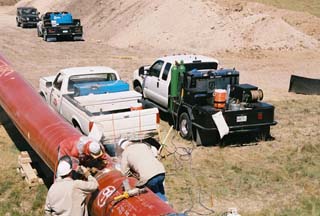 |
The PRO 300 features an 1,800 RPM CAT diesel engine, a 20- to 410-amp multi-process welding output capable of Stick, TIG, MIG, and flux-cored welding and 10 continuous kW of generator power. The unit weighs 1,200 lbs. (full of fuel) and measures 32 inches high, 26 inches wide and 56 inches deep. Compared to a 300-amp DC generator with a CV box, the PRO 300 provides a superior multiple-process welding arc, more welding generator power, uses less fuel, weighs less and costs less. It also features Miller's proven "Vault" design. The Vault is a cast aluminum, watertight case which houses the machines solid state control board (a board that is required for optimum wire welding performance).
To feed the wire, Associated Pipe Line chose the Miller SuitCase' 8VS wire feeder (Fig. 5), a voltage-sensing feeder with digital meters to confirm arc voltage and wire feed speed parameters. This 22-lb. feeder improves portability and holds a14-lb. spool of wire. Weems reported that the SuitCase™ held up very well and protected the wire from the dust, as well as rain.
 |
Fig. 5 The SuitCase 8VS wire feeders from Miller performed flawlessly in the dusty Colorado environment.
|
When it came to the guns, Associated Pipe Line selected the Bernard® 150-amp Q™-Guns. The flex-neck design was the most popular choice (see Fig. 6), though a few welders preferred the 90-degree gun.
"When we got the Bernard flex-neck guns, everyone was pleased with their performance," said Weems. "The key to flux-cored welding quality in this application is the gun angle. It needs to be directed straight at the joint or perhaps angled slightly back toward the puddle to provide good gas coverage. The flex-neck design let the welders bend the nozzle and get more comfortable."
|
Fig. 6 The Bernard 150-amp Q-Guns with flex-neck allowed the welders to position the arc and shielding gas right where they were needed, which made the flux-cored welding process easier to learn. Bernard's Centerfire consumables typically helped operators avoid tip changes during an entire shift.
|
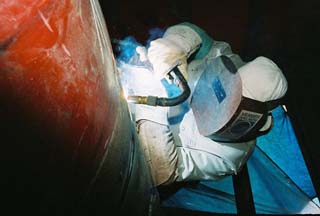 |
The Bernard Q-Gun comes packaged with Bernard's unique Centerfire consumables. The nozzle has a built-in spatter shield that completely protects the gas diffuser and removes turbulence from the gas flow. This feature extends consumable life and provides superior gas coverage. In addition, the nozzle's screw-on design maintains a fixed recess and a solid, concentric relationship between the tip and the nozzle. Most of the operators were able to avoid changing out tips during a whole shift, a factor that helped lower consumable costs and increase productivity.
Process Change Prompts Opinion Change
Associated Pipe Line brought on a crew of 12 pipeline welders and their rigs (trucks) for the tie-in welding. Like most U.S. pipe welders, this crew did not have experience flux-cored welding uphill, a method vital to preventing slag inclusion. With help from Sonny Daniell, a 30-year Local 798 pipeline veteran who provides field services for Miller and who also designed a rugged remote current/contactor tested on this project, training was accomplished in two fairly easy steps. First, Daniell spent time showing the operators how to set up the machine and then second, how to use the proper welding technique. As noted, maintaining gun angle relative to the weld puddle is important, as is keeping the wire directed into the center of the joint.
"Once they got the hang of it, it was not a problem," he says. "Also, the flex-neck guns made the process more forgiving by allowing them to access hard-to-hit areas of pipe and to position the head based on their individual welding styles."
While the rest of the world has used Miller welders on pipeline projects for decades, this is not the case in the North American market. Having never used a Miller diesel engine drive before, many of the Local 798 welders were initially hesitant to put a PRO 300 on their rig. "But if you went around and asked them now, most were quite satisfied," says Daniell. "They like the smoothness of the arc, the ability to run both stick and wire feed and the lower fuel consumption. The guys were using two to three gallons a day versus the eight to ten they used with the DC generators, and they were still running them just as hard. It made believers out of most all of the crew."
As testimony to the PRO 300's performance, operators were eager to provide their take on the engine drives. "It's a new experience to me," said veteran welder Lanny Dyer, "But I'm really enjoying it because, to me, it's a step ahead of what I've been using."
Welder Junior Blair added, "The PRO 300 welded really well. I mean, it has a smooth arc. One thing I liked was that I could just stick the bead pass in there without turning the heat up or down."
The PRO 300's four-position Dig control, to which Hankins refers, tailors the amount of Dig (arc force) for "soft" or "stiff" arcs with celluosic and low-hydrogen Stick electrodes. Arc force is the amount of "drive" created at the end of the electrode that pushes the molten metal into the joint. Depending on the situation, operators want either "soft" or "stiff" arc characteristics.
Hankins, with a welder's typical understated manner, calls the PRO 300's fuel economy "not bad," but in reality, the efficient design of this machine enables it to produce a 410-amp weld output with a 22-HP engine that uses almost half the fuel a DC generator does.
Gary Evans, another welder on the projects, stated, "I can run the PRO 300 for about four days before I fill up [it's 11.5 gal. tank], and afterwards I still have a quarter tank. If I was running a [competitive machine], I'd need to put in about 10 gallons a day. The fuel economy on the PRO 300 is great. We buy our own diesel, so using less fuel makes a big difference."
Considering that the average pipeline welder in the U.S. welds about 1,000 hours per year (as measured by the engine drive's hour meter) and that U.S. diesel prices are close to $2.00 per gallon the difference indeed adds up. The PRO 300 uses, conservatively, 40 percent less fuel than a DC generator, creating a savings of hundreds of dollars per year.
Quality and Results
Because pipelines must be built to last and operate in critical applications, the welding must be of the highest standard. Weldsonix inspected the pipeline with highly accurate automated ultrasonic testing (AUT) equipment that used ultrasound waves to gather details on the quality of all four layers of welds. In turn, highly trained and qualified AUT technicians interpreted this information, specifically checking for defects such as trapped slag, lack of fusion, porosity and weld cracking. Any weld with a defect longer than 25 mm must be repaired. Furthermore, if a bad weld runs more than 25 percent of the circumference of the pipe, that section of pipe must be completely cut out and may be replaced with a new 'pup' section (e.g., two joints welded). This replacement can cost thousands of dollars in equipment and labor. Getting a high level of quality right the first time is therefore a critical component of success.
"There is no question that there was continuous improvement throughout the project as the operators gained familiarity with the welding equipment and procedures," said Manuel, who also provided QA assistance during the project. The EWI Microalloying team provided an on-board welding, QA and NDE audit service to the project, including technical support to the contractor.
While the project management skill from Associated Pipe Line and the skill of the welders from Local 798 are the primary reasons that Spread 1 of the Cheyenne Plains project came in on time and under budget, Associated says equipment suppliers play an important role, too.
Dick Williams, project engineer with Associated, said, "We were willing to look into any process or product that benefited the pipeline owners and enabled us to complete our work more efficiently. Companies such as Miller, Hobart Brothers, Bernard and Airgas have served our needs here very well."